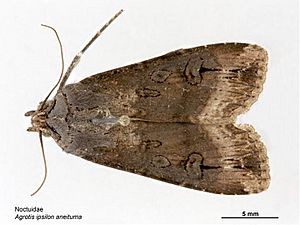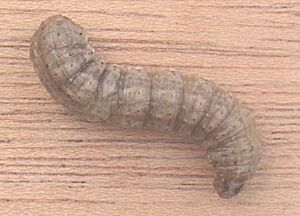Dark sword-grass facts for kids
Quick facts for kids Dark sword-grass |
|
|---|---|
 |
|
| Scientific classification | |
| Synonyms | |
|
The Agrotis ipsilon, also known as the dark sword-grass or black cutworm, is a small moth found all over the world. Its scientific name comes from the black markings on its front wings. These marks look like the letter "Y" or the Greek letter upsilon.
The young moths, called larvae, are known as "cutworms". They get this name because they cut down plants and crops. These larvae are serious pests for farmers. They eat almost all kinds of vegetables and many important grains.
This moth travels a lot! It flies north in the spring and south in the fall. This helps it avoid very hot summers and very cold winters. This travel pattern also shows when they reproduce. They lay eggs in spring and stop in the fall.
The moth goes through its whole life cycle in about two months. This includes the egg, larva, pupa, and adult stages. During this time, they can be eaten by predators or get sick from parasites. For example, Hexamermis arvalis and Archytas cirphis are known enemies.
Contents
- What Does the Dark Sword-Grass Moth Look Like?
- Where Do Dark Sword-Grass Moths Live?
- What Do Dark Sword-Grass Moths Eat?
- How Do Dark Sword-Grass Moths Lay Eggs?
- Life History of the Dark Sword-Grass Moth
- How Do Dark Sword-Grass Moths Damage Crops?
- Migration of Dark Sword-Grass Moths
- Enemies of the Dark Sword-Grass Moth
- How Do Humans Deal with Dark Sword-Grass Moths?
- See also
What Does the Dark Sword-Grass Moth Look Like?
This moth is about 3.8 to 4.8 centimeters wide. Male moths have feathery antennae. Their front wings are brown, sometimes with a reddish tint. They can also have pale gray or dark areas. The wings have black outlines around their spots.
The back wings are usually whitish-gray. They can be a bit darker at the edges.
The young larvae are usually brownish or bronzy-gray. Sometimes, they can look a bit green on their sides. Their heads often have dark brown spots.
Where Do Dark Sword-Grass Moths Live?
You can find these moths in many places around the world. They live in southern Canada, most of the United States, Mexico, Central and South America, Australia, New Zealand, and parts of Asia and Europe. They are also found in North Africa.
However, they do not live in some very hot tropical areas or very cold places. They are more common in the Northern Hemisphere than in the Southern Hemisphere.
As mentioned, these moths also travel. They fly north in the spring and south in the fall.
What Do Dark Sword-Grass Moths Eat?
Caterpillar Food
The young larvae, or caterpillars, eat weeds first. They like plants like bluegrass, curled dock, lambsquarters, yellow rocket, and redroot pigweed. Often, they will eat all the weeds in an area before they start eating crops.
Their favorite crops include most vegetable plants, alfalfa, clover, cotton, rice, sorghum, strawberry, sugarbeet, and tobacco. Sometimes, they also eat grains and grasses.
Adult Moth Food
Adult moths drink nectar from flowers. They also like deciduous trees and shrubs. These include linden, wild plum, crabapple, and lilac. They help pollinate a plant called fetterbush lyonia.
How Do Dark Sword-Grass Moths Lay Eggs?
Female black cutworm moths prefer to lay their eggs in areas with dry grass or other plant bits on the ground. This is often found near fencerows (like along pastures). They like these spots more than bare soil or corn fields.
Early in spring, before many plants grow tall, these dry grassy areas are very attractive. Later, as plants grow, the moths prefer to lay eggs on low, thick plants. These include curled dock and yellow rocket. These plants have many stems and leaves close to the ground. The moths usually lay eggs on the leaves, not the stems.
Life History of the Dark Sword-Grass Moth
Life Cycle
The number of generations (how many times they complete their life cycle) each year depends on where they live and the weather. In Canada, there are 1 or 2 generations. In the United States, there can be 2 to 4 generations each year.
These moths are very common in warmer places like Arkansas in late spring (May–June) and early fall (September–October). In cooler places like New York, they are more common in summer (June–July). One full life cycle takes between 35 and 60 days.
Egg Stage
The egg stage lasts for 3 to 6 days. Female moths lay their eggs in groups on low-lying leaves. If there are no host plants available, they will lay eggs on dead plant material. However, they will not lay eggs on bare soil. A female moth can lay eggs one by one, or in large groups of up to 1,200 to 1,900 eggs!
The eggs are almost perfectly round. They start white and turn brown as they get older. The surface of each egg has 35 to 40 ridges that spread out from one point.
Caterpillar Stage
The larval stage, when they are caterpillars, lasts 20 to 40 days. During this time, the caterpillar grows a lot. It goes through 5 to 9 instars (stages between molts). It starts at about 3.5 millimeters and can grow up to 55 millimeters long.
Caterpillars grow best at a temperature of 27 degrees Celsius. The first five stages grow best in high humidity. By the fourth stage, the caterpillar becomes sensitive to light. It spends most of the day underground. These larvae are considered pests because they damage plant tissue under the soil. They can also be cannibalistic, meaning they sometimes eat each other.
The caterpillar's color can be light gray, gray-brown, or even black. Its underside is usually lighter. This species does not have a dark stripe down its back. Its whole body is covered with small bumps, and its head has many dark spots.
Pupa Stage
The pupal stage lasts 12 to 20 days. During this time, the moth changes from a caterpillar into an adult. The pupa forms under the soil, usually about 3 to 12 millimeters deep.
The pupae are dark brown. They are about 1.7 to 2.2 centimeters long and 0.5 to 0.6 centimeters wide.
Adult Moth Stage
It takes about 35 to 60 days for a complete generation, from egg to adult moth. After a female moth becomes an adult, it takes her about 7 to 10 days before she starts laying eggs.
Adult moths have a wingspan of 4.0 to 5.5 centimeters. Their front wings are dark brown. They have a light, uneven band and a black dash mark near the outer edge. The back wings are whitish to gray and have darker veins.
How Do Dark Sword-Grass Moths Damage Crops?
These "gram cutworms" are active in the winter season in India. They cause damage to Rabi crops (winter crops).
- Cutworms are one of the few insects that damage winter crops.
- They cut plants down at the ground level. They can also twist the whole plant, like a gram plant. This is why they are called cutworms.
- They are also known as "surface caterpillars." This is because they stay near the soil surface and do their activities a few centimeters deep.
- The young larvae cause a lot of damage to crops. They hide during the day and come out in the evening to eat.
- First, they eat the outer layer of fallen leaves or green leaves touching the ground. Later, the caterpillars cut the leaves and shoots of plants right above the soil. Then they bury themselves in the soil.
- Cutworms damage many plants and cause serious harm. They attack gram fields between November and February.
Migration of Dark Sword-Grass Moths
A. ipsilon moths are insects that migrate with the seasons. They fly south in the fall to escape very cold weather. They fly north in the spring to avoid extremely hot weather. Changes in temperature and how long the days are (photoperiod) can affect when these moths start their migrations.
Enemies of the Dark Sword-Grass Moth
Predators
Several types of wasps hunt the black cutworm. When larvae are attacked by a type of parasitoid wasp called Meteorus leviventris, they eat 24% less food. They also cut 36% fewer seedlings. Other parasitoids include several fly species. These are Archytas cirphis, Bonnetia comta, Eucelatoria armigera, and Sisyropa eudryae.
Ground beetles also eat black cutworm larvae. Ants, especially Lasius neoniger, also hunt this species. They feed on the A. ipsilon eggs.
Parasites
A tiny worm called Hexamermis arvalis is a type of entomopathogenic nematode. It is known to infect 60% of larvae in the central United States. This parasite eventually kills the insect. The parasite grows best in moist soil.
How Do Humans Deal with Dark Sword-Grass Moths?
Pest of Crop Plants
Each larva can eat over 400 square centimeters of leaves as it grows. They eat above ground until they reach about their fourth stage of growth. After that, they cause a lot of damage to crops. They cut young plants at ground level.
In the midwestern US, the black cutworm is a serious pest for corn. Corn plants are very vulnerable when they have only one leaf. But by the time they have four or five leaves, they are usually not affected as much. Damage to the underground parts of plants can also be very harmful. Other crops that suffer serious damage include cotton, maize, tobacco, sunflower, tomatoes, sugar beet, and potatoes.
Managing Cutworm Populations
There are three main ways to manage cutworm populations and the damage they cause.
1. Soil insecticides before planting: Farmers can put insecticides in the soil before planting. However, it's hard to know exactly where the cutworms will be. 2. Soil insecticides at planting time: Insecticides can also be applied when the crops are planted. This has the same challenge of not knowing where the cutworms will be. 3. "Wait-and-see" treatment: The third option is to apply a treatment after the cutworm problem has already started. This is called a "rescue treatment." This method might be better now because there are fewer large outbreaks of cutworms.
See also
 In Spanish: Gusano cortador negro para niños
In Spanish: Gusano cortador negro para niños



